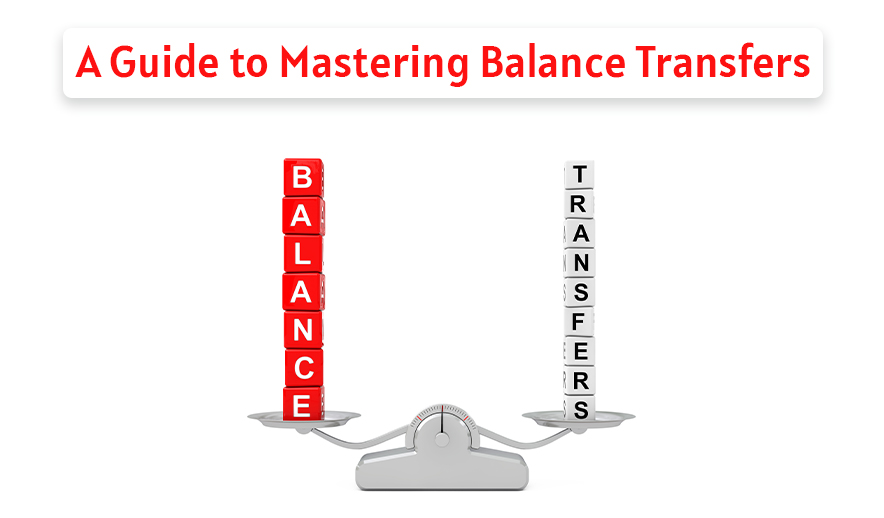
Transfer and Transform: A Guide to Mastering Balance Transfers

A balance transfer is a financial transaction where you move the outstanding balance from one credit card to another credit card, usually with a lower interest rate. The primary purpose of a balance transfer is to save money on interest payments or to consolidate multiple credit card debts into a single account.
Here’s how a balance transfer generally works:
Eligibility: To initiate a balance transfer, you typically need to have a credit card account with an available credit limit. Additionally, the credit card issuer may have specific eligibility criteria, such as a minimum credit score or debt-to-income ratio.
Application: You apply for a new credit card that offers a balance transfer facility. This can be done through the card issuer’s website, by phone, or by filling out an application form. Make sure to read the terms and conditions, including any promotional interest rates, balance transfer fees, and the duration of the offer.
Transfer Request: Once your new credit card is approved, you inform the new card issuer about your intention to transfer a balance from an existing credit card. This is typically done by providing the necessary details, such as the account number and outstanding balance of the old credit card.
Approval and Transfer: The new credit card issuer reviews your balance transfer request. If approved, they will arrange for the transfer of the specified amount from your old credit card to your new credit card. This may take a few days to process.
Repayment: After the balance transfer is completed, you will owe the transferred amount to the new credit card issuer. You will have to make monthly payments to repay the balance, following the terms and conditions of the new credit card. It’s important to make timely payments to avoid any interest charges or penalties.
Balance transfers are great tools for those who are transactors/ paying only the minimum dues ( and not the full month dues). These customers can benefit from the interest free period offered by the bank to move their high interest cards to a lower interest card. The saves can be in the form of interest and fees.
While specific credit card offerings can change over time, here are some popular credit cards in the UAE that have historically offered balance transfer facilities:
Emirates NBD Balance Transfer Credit Card: This card from Emirates NBD often provides balance transfer options with attractive interest rates and promotional periods.
Citibank Credit Cards: Citibank UAE has a range of credit cards that may offer balance transfer options with promotional interest rates and tenures.
Standard Chartered Bank Credit Cards: Standard Chartered Bank has credit cards like the Standard Chartered Platinum Card that have provided balance transfer facilities with favorable terms.
HSBC Credit Cards: HSBC UAE offers a variety of credit cards that have featured balance transfer offers in the past, including the HSBC Cashback Credit Card.
Mashreq Bank Credit Cards: Mashreq Bank has several credit cards that have featured balance transfer offers in the past, such as the Mashreq Platinum Elite and Mashreq SmartSaver Credit Cards.
ADCB SimplyLife Credit Card: The ADCB SimplyLife Credit Card offers balance transfer facilities at competitive interest rates and flexible repayment options.
It’s important to note that availability and specific terms of balance transfer offers can change, so it’s recommended to check with the respective banks for the most up-to-date information on their credit card offerings. Additionally, carefully review the terms and conditions, including any applicable fees, interest rates, and promotional periods before opting for a balance transfer.
Balance transfers offer several potential benefits, including:
Consolidating Debt: Balance transfers allow you to consolidate multiple credit card balances into a single account. This can simplify your finances by reducing the number of payments you need to make and potentially lowering your overall interest payments.
Lower Interest Rates: One of the primary advantages of balance transfers is the potential to obtain a lower interest rate on the transferred balance. Many credit card issuers offer promotional periods with 0% or low-interest rates for a specified period, which can help save money on interest charges.
Interest Savings: By transferring your balance to a credit card with a lower interest rate, you can reduce the amount of interest you pay over time. This can be especially beneficial if you have a high-interest rate on your existing credit card.
Pay Off Debt Faster: With a lower interest rate, more of your payment goes towards reducing the principal balance. This can enable you to pay off your debt faster and potentially save money in the long run.
Simplified Payments: Consolidating your balances through a balance transfer means you only have to make one payment to a single credit card issuer, which can be more convenient and easier to manage.
Potential Rewards or Benefits: Some balance transfer credit cards may offer rewards programs, cashback incentives, or other benefits that can enhance the value of transferring your balance. This allows you to potentially earn rewards while paying off your debt.
It’s important to note that while balance transfers can offer significant benefits, there are also some considerations to keep in mind. These include balance transfer fees, promotional period limitations, potential impact on your credit score, and the need to make consistent payments to fully take advantage of the benefits.
Before opting for a balance transfer, it’s essential to carefully review the terms and conditions of the new credit card, including any fees, interest rates after the promotional period, and other factors. Assess your financial situation and determine if a balance transfer aligns with your repayment goals and overall financial strategy.
To perform a balance transfer on a credit card, you can follow these general steps:
Review Terms and Conditions: Understand the terms and conditions of your credit card, including any specific rules or limitations regarding balance transfers. Check if your credit card allows balance transfers and if there are any associated fees or promotional offers.
Identify the Transfer Amount: Determine the amount you want to transfer from one credit card to another. This can include the entire outstanding balance or a portion of it.
Compare Balance Transfer Offers: Research credit cards that offer balance transfer facilities and compare their terms, interest rates, fees, and promotional periods. Look for credit cards that provide favorable terms for balance transfers, such as low or 0% introductory interest rates.
Apply for a New Credit Card: If you don’t have a credit card with a balance transfer feature, apply for a new credit card that offers this service. Ensure you meet the eligibility criteria and provide all the required documents during the application process.
Gather Account Information: Collect the necessary information from the credit card you want to transfer the balance from, such as the card number, outstanding balance, and the account details of the issuing bank.
Initiate the Balance Transfer: Contact the credit card issuer of the new credit card (where you want to transfer the balance) through their customer service hotline or online banking platform. Inform them of your intention to perform a balance transfer.
Provide Details: Provide the required information, including the credit card number, outstanding balance, and account details of the existing credit card. Additionally, you may need to specify the transfer amount or any specific instructions.
Verify Transfer Terms: Confirm the terms and conditions of the balance transfer, including any associated fees, interest rates, promotional periods, and repayment terms. Clarify any doubts or questions you may have before proceeding.
Await Processing: The credit card issuer will process the balance transfer request. This may take a few days or longer, depending on the issuing bank’s procedures.
Monitor Progress: Keep track of the balance transfer process. Ensure that the balance transfer is completed as expected and that the outstanding balance is reflected on the new credit card.
Repayment and Management: Once the balance transfer is successful, make regular payments according to the terms and conditions of the new credit card. Consider developing a repayment plan to manage the transferred balance effectively.
Remember, the specific process and requirements for balance transfers may vary depending on the credit card issuers and their respective policies. It’s important to carefully review the terms and conditions of both credit cards involved and contact the respective customer service if you have any questions or need assistance with the balance transfer process.



